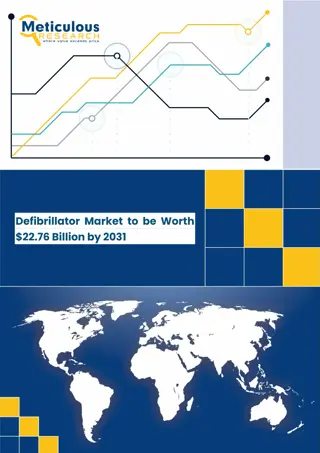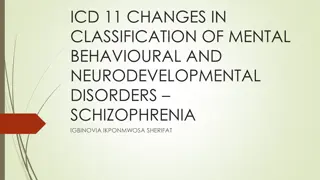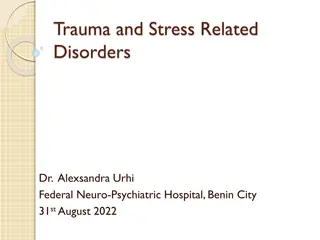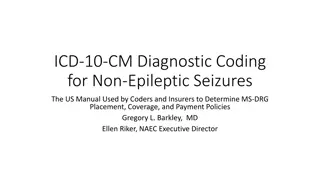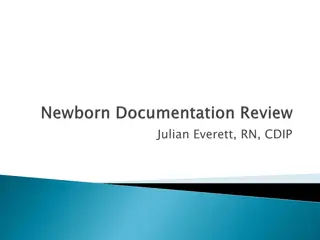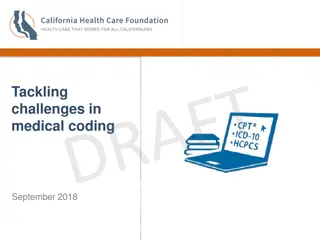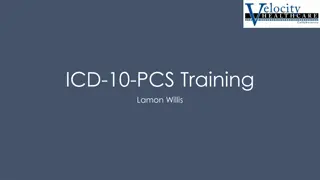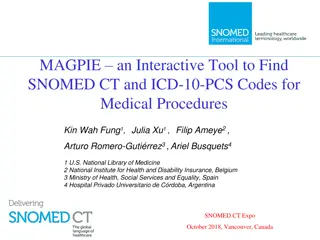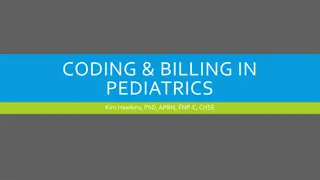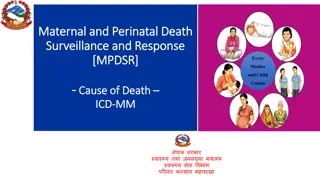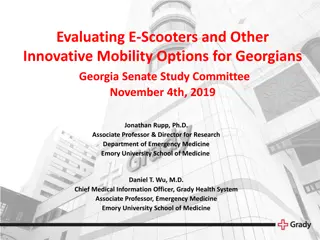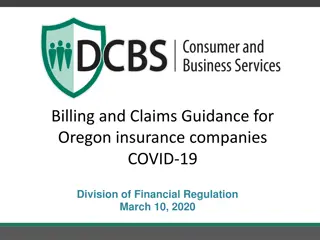ICD-10 CM Training
ICD-10-CM Endocrinology Training provides essential information on compliance dates, covered and non-covered entities, code structure, placeholders, and 7th character descriptions in medical coding. Explore the details to enhance your understanding of endocrine-related ICD-10 codes.
Download Presentation

Please find below an Image/Link to download the presentation.
The content on the website is provided AS IS for your information and personal use only. It may not be sold, licensed, or shared on other websites without obtaining consent from the author.If you encounter any issues during the download, it is possible that the publisher has removed the file from their server.
You are allowed to download the files provided on this website for personal or commercial use, subject to the condition that they are used lawfully. All files are the property of their respective owners.
The content on the website is provided AS IS for your information and personal use only. It may not be sold, licensed, or shared on other websites without obtaining consent from the author.
E N D
Presentation Transcript
ICD-10 CM Training Endocrinology
ICD-10-CM Compliance Dates ICD-10-CM will be valid for dates of service on or after October 1, 2015 Outpatient dates of service of October 1, 2015 and beyond. Inpatient hospital service claims, is effective for dates of discharge after September 30, 2015
Covered and Non-Covered Entities Covered Entities Everyone covered by the Health Insurance Portability Accountability Act (HIPAA) Non-Covered Entities Worker s Compensation Auto Insurance Non covered HIPAA entities are exempt but are encouraged to adapt the new code set
ICD-10 Code Structure 21 Chapters Alpha-numeric codes; not case-sensitive Codes begin with Alpha letter, A-Z, excluding U Common errors I verses 1 O verses 0 x Placeholder 3 to 7 characters Decimal following 3rdcharacter
ICD-10 Code Structure Placeholder x Used for future expansion of a code Fills in empty characters when a 6thand/or 7thcharacter apply The placeholder may be used in different scenarios but should never serve as the final character. Example: W19.XXXA Unspecified fall, Initial Encounter
ICD-10 Code Structure 7thCharacter Provides specified information regarding the clinical visit Is required for certain categories and must be reported in the seventh position May be alpha or numeric Has different meanings depending on the coding category
ICD-10 Code Structure 7thCharacter Description A Initial encounter for closed fracture B Initial encounter for open fracture type I or II, or NOS C Initial encounter for open fracture type IIIA, IIIB, or IIIC D Subsequent encounter for closed fracture with routine healing E Subsequent encounter for open fracture of type I or II with routine healing F Subsequent encounter for open fracture of type IIIA, IIIB, or IIIC with routine healing G Subsequent encounter for closed fracture with delayed healing H Subsequent encounter for open fracture of type I or II with delayed healing J Subsequent encounter for open fracture of type IIIA, IIIB, or IIIC with delayed healing K Subsequent encounter for closed fracture with nonunion M Subsequent encounter for open fracture of type I or II with nonunion N Subsequent encounter for open fracture of type IIIA, IIIB, or IIIC with nonunion P Subsequent encounter for closed fracture with malunion Q Subsequent encounter for open fracture of type I or II with malunion R Subsequent encounter for open fracture of type IIIA, IIIB, or IIIC with malunion S Sequela
ICD-10 Code Structure Laterality Some ICD-10-CM codes indicate laterality, specifying whether the condition occurs on the left, right or is bilateral. If no bilateral code is provided and the condition is bilateral, assign separate codes for both the left and right side. If the side is not identified in the medical record, assign the code for the unspecified side. OGCR section 1.B.13
ICD-10 Code Structure Other Codes Codes titled other or other specified are for use when the information in the medical record provides detail for which a specific code does not exist. Unspecified Codes Codes titled unspecified are for use when the information in the medical record is insufficient to assign a more specific code. OGCR section 1.A.9.a.b
ICD-10 Structure Excludes Notes Excludes1 A type 1 Excludes note is a pure excludes note It means NOT CODED HERE The code excluded should never be used at the same time When two conditions cannot occur together Excludes2 Represents Not included here The condition excluded is not part of the condition represented by the code It is acceptable to use both the code and the excluded code together, when appropriate OGCR section 1.A.12.a.b
ICD-10 Code Structure Code First and Use Additional Code ICD-10 has a coding convention that requires the underlying condition be sequenced first followed by the manifestation. These instructional notes indicate the proper sequencing order of the codes. OGCR section 1.A.13 The - indicates there are additional reporting options
Vitamin D deficiency, unspecified ICD-9 Code ICD-10 Code Description Excludes1 Excludes2 268.9 E55.9 Vitamin D deficiency, unspecified Adult osteomalacia (M83.-) Osteoporosis (M80.-) Sequelae of rickets (E64.3) Nutritional anemias (D50- D53) Applicable To: Avitaminosis D
Mixed hyperlipidemia ICD-9 Code ICD-10 Code Description Excludes1 Excludes2 272.2 E78.2 Mixed hyperlipidemia Sphingolipidosis (E75.0-E75.3) cerebrotendino us cholesterosis [van Bogaert- Scherer- Epstein] (E75.5) familial combined hyperlipidemia (E78.4) N/A Applicable To: Broad- or floating- betalipoproteinemia Combined hyperlipidemia NOS Elevated cholesterol with elevated triglycerides NEC Fredrickson's hyperlipoproteinemia, type IIb or III Hyperbetalipoproteinemia with prebetalipoproteinemia Hypercholesteremia with endogenous hyperglyceridemia Hyperlipidemia, group C Tubo-eruptive xanthoma Xanthoma tuberosum
Hyperlipidemia Documentation Tips Type Mixed Other Unspecified
Elevated C-reactive protein (CRP) ICD-9 Code ICD-10 Code Description Excludes1 Excludes2 790.95 R79.82 Elevated C-reactive protein (CRP) abnormality of fluid, electrolyte or acid-base balance (E86-E87) asymptomatic hyperuricemia (E79.0) hyperglycemia NOS (R73.9) hypoglycemia NOS (E16.2) neonatal hypoglycemia (P70.3- P70.4) specific findings indicating disorder of amino-acid metabolism (E70-E72) specific findings indicating disorder of carbohydrate metabolism (E73-E74) specific findings indicating disorder of lipid metabolism (E75.-) N/A There are more specific code choice selections below: R79.81 Abnormal blood-gas level R79.89 Other specified abnormal findings of blood chemistry
Documentation Tips Use additional code to identify any retained foreign body, if applicable (Z18.-)
Signs and symptoms ICD-10-CM R00-R99 Acceptable to code when a related definitive diagnosis has not been established (confirmed) by the provider. Signs and symptoms that are associated routinely with a disease process should not be assigned as additional codes, unless otherwise instructed by the classification. Additional signs and symptoms that may not be associated routinely with a disease process should be coded when present.
Use of symptom codes Codes for signs and symptoms may be reported in addition to a related definitive diagnosis when the sign or symptom is not routinely associated with that diagnosis, such as the various signs and symptoms associated with complex syndromes. The definitive diagnosis code should be sequenced before the symptom code
Obesity ICD-9 Code ICD-10 Code Description Excludes1 Excludes2 278.00 E66.9 Obesity, unspecified Obesity NOS Code first obesity complicating pregnancy, childbirth and the puerperium, if applicable (O99.21-) Use additional code to identify body mass index (BMI), if known (Z68.-) Adiposogenital dystrophy (E23.6) Lipomatosis NOS (E882.) Lipomatosis dolorosa [Dercum] (E88.2) Prader-Willi Syndrome (Q87.1) N/A There are more specific code choice selections below: 278.01 E66.01 Morbid (severe) obesity due to excess calories 278.00 E66.09 Other obesity due to excess calories 278.00 E66.1 Drug-induced obesity 278.03 E66.2 Morbid (severe) obesity with alveolar hypoventilation 278.02 E66.3 Overweight 278.00 E66.8 Other obesity
Overweight and Obesity Adult, 21 years and older Weight Status Category Body Mass Index Range Overweight 25.0-29.9 Obese 30.0-49.9 Morbid Obese 50.0-59.9 Pediatric, 2-20 years Weight Status Category Percentile Range Less than the 5th percentile Underweight 5th percentile to less than the 85th percentile Normal or Healthy Weight 85th to less than the 95th percentile Overweight Obese Equal to or greater than the 95th percentile
Obesity Documentation Tips Identify condition: Obesity Drug-induced Use additional code for adverse effect, if applicable to identify drug (T36-T50) with fifth or sixth character 5) Due to excess calories Morbid Other Morbid/severe with alveolar hypoventilation (Body Mass Index 50- 59.9, ) Other Overweight (Body Mass Index 25-29.9) Use additional code to identify body mass index (BMI), if known (Z68
Overweight Body Mass Index (BMI) 21 years of age and older Z68.1 Body mass index (BMI) 19 or less, adult Z68.20 Body mass index (BMI) 20.0-20.9, adult Z68.21 Body mass index (BMI) 21.0-21.9, adult Z68.22 Body mass index (BMI) 22.0-22.9, adult Z68.23 Body mass index (BMI) 23.0-23.9, adult Z68.24 Body mass index (BMI) 24.0-24.9, adult Z68.25 Body mass index (BMI) 25.0-25.9, adult Z68.26 Body mass index (BMI) 26.0-26.9, adult Z68.27 Body mass index (BMI) 27.0-27.9, adult Z68.28 Body mass index (BMI) 28.0-28.9, adult Z68.29 Body mass index (BMI) 29.0-29.9, adult
Obese Body Mass Index (BMI) 21 years of age and older Z68.30 Body mass index (BMI) 30.0-30.9, adult Z68.31 Body mass index (BMI) 31.0-31.9, adult Z68.32 Body mass index (BMI) 32.0-32.9, adult Z68.33 Body mass index (BMI) 33.0-33.9, adult Z68.34 Body mass index (BMI) 34.0-34.9, adult Z68.35 Body mass index (BMI) 35.0-35.9, adult Z68.36 Body mass index (BMI) 36.0-36.9, adult Z68.37 Body mass index (BMI) 37.0-37.9, adult Z68.38 Body mass index (BMI) 38.0-38.9, adult Z68.39 Body mass index (BMI) 39.0-39.9, adult
Morbid Obese Body Mass Index (BMI) 21 years of age and older Z68.41 Body mass index (BMI) 40.0-44.9, adult Z68.42 Body mass index (BMI) 45.0-49.9, adult Z68.43 Body mass index (BMI) 50-59.9 , adult Z68.44 Body mass index (BMI) 60.0-69.9, adult Z68.45 Body mass index (BMI) 70 or greater, adult
Pediatric BMI Body Mass Index (BMI) 2-20 years of age Z68.51 Body mass index (BMI) pediatric, less than 5th percentile for age Z68.52 Body mass index (BMI) pediatric, 5th percentile to less than 85th percentile for age Z68.53 Body mass index (BMI) pediatric, 85th percentile to less than 95th percentile for age Z68.54 Body mass index (BMI) pediatric, greater than or equal to 95th percentile for age
Abnormal Glucose ICD-9 Code ICD-10 Code Description Excludes1 Excludes2 790.21 R73.01 Impaired Fasting glucose Elevated fasting glucose Abnormal glucose in pregnancy (O99.81-) Diabetes mellitus (E08-E13) Dysmetabolic syndrome X (E88.81) Gestational diabetes (O24.4-) Glycosurai (R81) Hypoglycemia (E16.2) N/A There are more specific code choice selections below: 790.22 R73.02 Impaired glucose tolerance (oral) 790.29 R73.09 Other abnormal glucose
Abnormal Glucose Documentation Tips Type Elevated fasting glucose R73.01 Elevated glucose tolerance R73.02 Abnormal glucose NOS R73.09 Abnormal non-fasting glucose tolerance Latent diabetes Pre-diabetes
Menopausal and female climacteric states ICD-9 Code ICD-10 Code Description Excludes1 Excludes2 627.2 N95.1 Menopausal and female climacteric states excessive bleeding in the premenopausal period (N92.4) menopausal and perimenopausal disorders due to artificial or premature menopause (E89.4-, E28.31-) premature menopause (E28.31-) asymptomatic menopausal state (Z78.0) symptoms associated with artificial menopause (E89.41) symptoms associated with premature menopause (E28.310) postmenopausal osteoporosis (M81.0-) postmenopausal osteoporosis with current pathological fracture (M80.0-) postmenopausal urethritis (N34.2) Use additional code for associated symptoms
Menopausal Documentation Tips Symptoms such as flushing, sleeplessness, headache, lack of concentration, associated with natural (age- related) menopause
Hypothyroidism ICD-9 Code ICD-10 Code Description Excludes1 Excludes2 244.9 E03.9 Hypothyroidism, unspecified Iodine- deficiency related hypothyroidism (E00-E02) Postprocedural hypothyroidism (E89.0) N/A There are more specific code choice selections below: 243 E03.0 Congenital hypothyroidism with diffuse goiter 243 E03.1 Congenital hypothyroidism without goiter 244.2 244.3 E03.2 Hypothyroidism due to medicaments and other exogenous substances 244.8 E03.3 Postinfectious hypothyroidism 246.8 E03.4 Atrophy of thyroid (acquired) 780.01 E03.5 Myxedema coma 244.8 E03.8 Other specified hypothyroidism
Hypothyroidism Documentation Tips Identify Congenital Hypothyroidism With goiter Without goiter Identify Acquired Hypothyroidism Due to acquired atrophy of the thyroid Due to medication Postinfectious Postprocedural Subclinical iodine-deficiency Other Unspecified type
Vitamin B Deficiency ICD-9 Code ICD-10 Code Description Excludes1 Excludes2 Sequelae of vitamin B deficiency (E64.8) Folate deficiency anemia (D52.1-) Vitamin B12 deficiency anemia nutritional anemias (D50-D53) 266.2 E53.8 Deficiency of other specified B group vitamins Applicable to: Biotin deficiency Cyanocobalamin deficiency Folate deficiency Folic acid deficiency Pantothenic acid deficiency Vitamin B12 deficiency 266.0 E53.0 Riboflavin deficiency Ariboflavinosis Vitamin B2 deficiency N/A N/A 266.1 E53.1 Pyridoxine deficiency Vitamin B6 deficiency 266.9 E53.9 Vitamin B deficiency, unspecified N/A N/A
Disorder of adrenal gland, unspecified ICD-9 Code ICD-10 Code Description Excludes1 Excludes2 255.9 E27.9 Disorder of adrenal gland, unspecified galactorrhea (N64.3) gynecomastia (N62) N/A There are more specific code choice selections below: E27.0 Other adrenocortical overactivity E27.1 Primary adrenocortical insufficiency E27.2 Addisonian crisis E27.3 Drug-induced adrenocortical insufficiency E27.40 Unspecified adrenocortical insufficiency E27.41 Other adrenocortical insufficiency E27.5 Adrenomedullary hyperfunction E27.8 Other specified disorders of adrenal gland
Other abnormal blood chemistry ICD-9 Code ICD-10 Code Description Excludes1 Excludes2 790.6 R79.89 Finding of other specified substances, not normally found in blood abnormalities (of)(on): abnormal findings on antenatal screening of mother (O28.-) coagulation hemorrhagic disorders (D65-D68) lipids (E78.-) platelets and thrombocytes (D69.-) white blood cells classified elsewhere (D70-D72) diagnostic abnormal findings classified elsewhere - see Alphabetical Index hemorrhagic and hematological disorders of newborn (P50- P61)abnormality of fluid, electrolyte or acid-base balance (E86-E87) asymptomatic hyperuricemia (E79.0) hyperglycemia NOS (R73.9) hypoglycemia NOS (E16.2) neonatal hypoglycemia (P70.3-P70.4) specific findings indicating disorder of amino-acid metabolism (E70-E72) specific findings indicating disorder of carbohydrate metabolism (E73-E74) specific findings indicating disorder of lipid metabolism (E75.-) N/A R79.0 Abnormal level of blood mineral Use additional code to identify any retained foreign body, if applicable (Z18.-)
Testicular hypofunction ICD-9 Code ICD-10 Code Description Excludes1 Excludes2 257.2 E29.1 Testicular hypofunction galactorrhea (N64.3) gynecomastia (N62) androgen insensitivity syndrome (E34.5-) azoospermia or oligospermia NOS (N46.0-N46.1) isolated gonadotropin deficiency (E23.0) Klinefelter's syndrome (Q98.0-Q98.2, Q98.4) postprocedural testicular hypofunction (E89.5) N/A Applicable To: Defective biosynthesis of testicular androgen NOS 5-delta-Reductase deficiency (with male pseudohermaphro ditism) Testicular hypogonadism NOS Use Additional code for adverse effect, if applicable, to identify drug (T36-T50 with fifth or sixth character 5)
Testicular hypofunction Documentation Tips All neoplasms, whether functionally active or not, are classified in Chapter 2. Appropriate codes in this chapter (i.e. E05.8, E07.0, E16-E31, E34.-) may be used as additional codes to indicate either functional activity by neoplasms and ectopic endocrine tissue or hyperfunction and hypofunction of endocrine glands associated with neoplasms and other conditions classified elsewhere.
Diabetes ICD-9 Code ICD-10 Code Description Excludes1 Excludes2 250.00 E11.9 Type 2 Diabetes mellitus without complications Diabetes (mellitus) due to insulin secretory defect Diabetes (NOS) Insulin resistant diabetes (mellitus) Diabetes mellitus due to underlying condition (E08.-) Drug or chemical induced diabetes mellitus (E09.1-) Gestational diabetes (O24.4-) Neonatal diabetes mellitus (P70.2) Postpancreatectomy diabetes mellitus (E13.-) Postprocedural diabetes mellitus (E13.-) Secondary diabetes mellitus NEC (E13.-) Type 1 diabetes mellitus (E10.-) N/A Use additional code to identify any insulin use (Z79.4)
Diabetes Documentation Tips Diabetes is a chronic condition that requires multi-specialty management. The documentation should indicate relevant details regarding the management of each case as it relates to the services rendered or actions taken to coordinate the patients care. The HPI, at a minimal, should include some indication of the historical timeline or duration of the illness, levels as it relates to the date of service, manifestations or impairments associated with the condition and effectiveness of current medication regimen. The examination should notate any physical signs related to the diabetic conditions. (Ulcers, nails, edema, discoloration, sensitivity to touch)
Diabetes Documentation Tips Indicate Type Indicate additional conditions, manifestations, or complications Cataract Circulatory complication Foot ulcer Gastroparesis Notate causal relationships (due to, with, secondary) State due to drugs or chemicals
Hypertension ICD-9 Code ICD-10 Code Description Excludes1 Excludes2 401.1 401.9 401.0 I10 Essential (Primary) Hypertension Includes: high blood pressure, Hypertension (arterial) (benign) (essential) (malignant) (systemic) Hypertensive disease complicating pregnancy, childbirth and the puerperium (O10-O11, O13-O16) Neonatal hypertension (P29.2) Primary pulmonary hypertension (I127.0) Essential (primary) hypertension involving vessels of brain (I60-I69) Essential (primary) hypertension involving vessels of eye (H35.0-) Hypertensive Diseases Categories (I10-I15) (I10-I15) Use additional code to identify: Exposure to environmental tobacco smoke (Z77.22) History of tobacco use (Z87.891) Occupational exposure to environmental tobacco smoke (Z57.31) Tobacco dependence (F17.-) Tobacco use (Z72.0) Hypertensive disease complicating pregnancy, childbirth and the puerperium (O10-O11. O13-O16) Neonatal hypertension (P29.2) Primary Pulmonary hypertension (I27.0) The use additional codes and Excludes1 codes apply for all categories.
Hypertension cont. ICD-9 Code ICD-10 Code Description Excludes1 Excludes2 402.01 402.11 402.91 I11.0 Hypertensive Heart Disease with heart failure Use additional code to identify type of heart failure (I50.-) N/A N/A 402.00 402.10 402.90 I11.9 Hypertensive Heart Disease without heart failure N/A N/A 403.01 403.11 403.91 I12.0 Hypertensive Chronic Kidney Disease with stage 5 Chronic Kidney Disease or end stage renal disease. Use additional code to identify the stage of chronic kidney disease (N185.5, N18.6) Hypertension due to Kidney Disease (I15.0, I15.1) Renovascular Hypertension (I15.0) Secondary Hypertension (I115.-) Acute Kidney Failure (N17.-) 403.00 403.10 403.90 I12.9 Hypertensive Chronic Kidney Disease with stage 1-4 Chronic Kidney Disease, or unspecified Chronic Kidney Disease. Use additional code to identify the stage of chronic kidney disease (N18.1-N18.9) Hypertension due to Kidney Disease (I15.0, I15.1) Renovascular Hypertension (I15.0) Secondary Hypertension (I115.-) Acute Kidney Failure (N17.-)
Hypertension cont. ICD-9 Code ICD-10 Code Description Excludes1 Excludes2 404.01 404.11 404.91 I13.0 Hypertensive heart and chronic kidney disease with heart failure and stage 1-4 chronic kidney disease, or unspecified chronic kidney disease Use additional code to identify type of heart failure (I50.-) Use additional code to identify stage of chronic kidney disease (N18.1-NN18.4, N18.9) N/A N/A 404.00 404.10 404.90 I13.10 Hypertensive Heart and Chronic Kidney Disease without heart failure, with stage 1-4 chronic kidney disease, or unspecified chronic kidney disease. Use additional code to identify the stage of chronic kidney disease (N18.1-N18.4, N18.9) N/A N/A 404.02 404.12 404.92 I13.11 Hypertensive heart and chronic kidney disease without heart failure, with stage 5 chronic kidney disease or end stage renal disease. Use additional code to identify the stage of chronic kidney disease (N18.5, N18.6) N/A N/A 404.03 404.13 404.93 I13.2 Hypertensive heart and chronic kidney disease with heart failure and with stage 5 chronic kidney disease, or end stage renal disease. Use additional code to identify type of heart failure (I50.-) Use additional code to identify the stage of chronic kidney disease (N18.5. N18.6) N/A N/A
Hypertension cont. ICD-9 Code ICD-10 Code Description Excludes1 Excludes2 405.01 405.11 405.91 I15.0 Renovascular Hypertension Code also underlying condition Postprocedural hypertension (I97.3) Secondary hypertension involving vessels of brain (I60-I69) Secondary hypertension involving vessels of eye (H35.0-) 405.91 I15.1 Hypertension secondary to other renal disorders Code also underlying condition Postprocedural hypertension (I97.3) Secondary hypertension involving vessels of brain (I60-I69) Secondary hypertension involving vessels of eye (H35.0-) 405.99 I15.2 Hypertension secondary to endocrine disorders Code also underlying condition Postprocedural hypertension (I97.3) Secondary hypertension involving vessels of brain (I60-I69) Secondary hypertension involving vessels of eye (H35.0-) 405.09 405.19 405.99 I15.8 Other secondary hypertension Code also underlying condition Postprocedural hypertension (I97.3) Secondary hypertension involving vessels of brain (I60-I69) Secondary hypertension involving vessels of eye (H35.0-) 405.99 I15.9 Secondary hypertension, unspecified Code also underlying condition Postprocedural hypertension (I97.3) Secondary hypertension involving vessels of brain (I60-I69) Secondary hypertension involving vessels of eye (H35.0-)
Hypertension Documentation Tips Hypertension is no longer classified as benign, malignant or unspecified. ICD-10 Codes have been grouped according to disease progression: I10 Essential Hypertension I11.- Hypertensive Heart Disease I12.- Hypertensive CKD Further subdivided by stage of kidney disease I13.- Hypertensive Heart and CKD Further subdivided by stage of kidney disease I15.- Secondary Hypertension Transient Hypertension A code for hypertension is NOT assigned unless the patient has a documented, established diagnosis of hypertension. R03.0 Elevated blood pressure reading without diagnosis of hypertension Document requirements Type Current Status Associated relationships
Other Malaise and Fatigue ICD-9 Code ICD-10 Code Description Excludes1 Excludes2 age-related weakness (R54) muscle weakness (M62.8-) senile asthenia (R54) 780.79 R53.1 Weakness Asthenia NOS N/A age-related physical debility (R54) 780.79 R53.81 Other malaise Chronic debility Debility NOS General physical deterioration Malaise NOS Nervous debility N/A Postviral fatigue syndrome NOS 780.79 R53.82 Chronic fatigue, unspecified N/A 780.79 R53.83 Other fatigue Fatigue NOS Lack of energy Lethargy Tiredness N/A N/A
Other Malaise and Fatigue Documentation Tips Identify type of malaise and fatigue Neoplastic related fatigue Weakness Functional quadriplegia Other malaise Chronic fatigue, unspecified Other fatigue
Mineral deficiency not elsewhere classified ICD-9 Code ICD-10 Code Description Excludes1 Excludes2 269.3 E58 Mineral deficiency not elsewhere classified disorders of calcium metabolism (E83.5-) sequelae of calcium deficiency (E64.8) nutritional anemias (D50- D53) E59 Dietary selenium deficiency E60 Dietary zinc deficiency E61.4 Chromium deficiency E61.5 Molybdenum deficiency
Documentation Start Now All Conditions treated or assessed must be documented in the medical record. In addition to the documentation tips reviewed, below are more areas to document that will ensure proper ICD-10-CM code selection. Site specificity Document notation of qualifiers Exacerbation Manifestations Relapse Status Stages Indicate acute or chronic Indicate underlying or external cause factors Medication Smoke Accidents Mechanical failure Laterality Bilateral Right Left
Documentation Start Now Episode of Care for injuries, poisoning, external causes and other conditions Initial Encounter Use while the patient is receiving active treatment of the condition Active treatment includes surgical treatment, an emergency encounter, and evaluation and treatment by a new physician Subsequent Encounter Used on encounter after the patient has received active treatment of the condition and is receiving routine care for the condition during the healing or recovery phase. Medication adjustments, aftercare, device adjustments, cast change Sequela Used for complications or conditions that arise as a direct result of a condition, late effect


